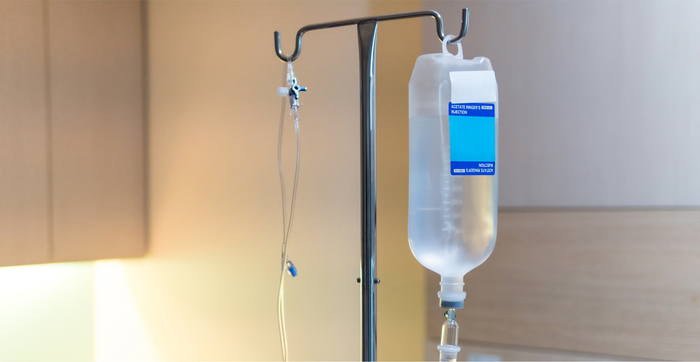
Feel better faster. Get care today.
From the clinic or your couch. Find high quality, same-day urgent care for you and your kids. Book an urgent care visit today.

If you’ve ever sought medical care at a hospital or emergency room, you have likely received treatment via intravenous (IV) fluids. IV fluids are a common way to deliver hydration, nutrients, and medications straight into the bloodstream. Additionally, having an IV established is a common practice during many medical visits because it gives providers a fast route to deliver medications if necessary. An IV is also the preferred way to deliver several medications, according to the Cleveland Clinic.
Urgent care facilities are a quick and convenient option for getting treatment for non-emergent illnesses and injuries. Urgent care clients are equipped to handle a wide range of medical issues. From minor injuries like simple bone fractures and minor cuts to non-life-threatening infections like UTIs, and illnesses like influenza or COVID-19—and a common treatment for many conditions involves getting IV fluids.
IV fluids are liquid solutions that are administered directly into your bloodstream through a small tube called a catheter. The catheter is placed in a vein in your arm or hand using a small needle. The fluids are made up of a combination of water, electrolytes, and other nutrients, according to the Cleveland Clinic.
The purpose of IV fluids is to help maintain your body's fluid balance, which is essential for proper organ function. When your body is dehydrated or has lost fluids due to an illness or injury, it can lead to a number of health issues, including low blood pressure, kidney failure, and even death, warns the Cleveland Clinic. IV fluids help to prevent these complications and are also used to administer certain medications.

From the clinic or your couch. Find high quality, same-day urgent care for you and your kids. Book an urgent care visit today.
IV fluids are used in many healthcare settings, including emergency rooms, hospitals, outpatient surgery centers, and ambulances. Because IV fluids provide quick and effective relief for a variety of medical conditions, they are often also used at urgent care clinics, notes the Cleveland Clinic.
Urgent care clinics have trained medical professionals who can determine if IV fluids are a good treatment option for you and then safely administer IV fluids if you do need them. Before receiving IV fluids, your urgent care provider will consider factors such as your medical history, current medications, and any allergies you may have—then they will assess your current medical situation and determine if IV fluids are a necessary and safe option for you.
IV fluid administration is a common medical procedure that is used to treat a variety of conditions. Here are some of the situations when the Cleveland Clinic notes IV fluids are usually necessary:
When you arrive at an urgent care clinic and your healthcare provider determines that you need IV fluids, they will start the process by cleaning the area where the IV will be inserted. Usually, this includes wiping your skin with an alcohol prep pad, to disinfect the area from germs, according to procedure steps outlined by the National Library of Medicine (NLM). Your provider will then use a small needle to gain access to a vein in your arm or hand. Attached to the needle is a small catheter which is then inserted into your vein and will remain there throughout the course of receiving IV fluids. The needle, however, is removed once the soft catheter is in place. This procedure usually takes a few minutes and is associated with minimal pain. Some providers will opt to use a numbing agent on the skin or a Doppler device to help locate the veins underneath your skin.
After the catheter has successfully been placed in your vein, it is connected to a tube that connects to the bag of IV fluids. The healthcare provider will then adjust the flow rate of the fluid to ensure that you receive the appropriate amount of fluid. The flow rate can be adjusted throughout the treatment as needed. Many times, a machine known as an IV pump is used to maintain a consistent flow of fluids, notes the NLM.
After your IV is placed, your healthcare provider may monitor your vital signs and symptoms during the entire process to ensure that you are responding well to the treatment. If you require medication to be administered through the IV, the healthcare provider will add it to the IV bag or give it separately through the tube connected to the IV.
It's important to note that IV placement is generally a painless process, but some people may experience mild discomfort or a slight pinch when the needle is inserted. If you experience any significant pain or discomfort during the process, be sure to let the healthcare provider know so they can make adjustments as needed.
When you receive IV fluid administration at an urgent care facility, you may receive one of several types of fluids. The type of fluid you receive will depend on your specific needs and medical condition. The most common types of IV fluids, as outlined by the Cleveland Clinic are:
There are several different ways that IV fluids can be administered. The most commonly used method, according to Johns Hopkins, is a peripheral IV. This is the method that uses a small needle to gain access to a vein in your arm or hand, to place a catheter. Depending on your specific illness or injury, a more advanced method may be necessary. Advanced methods are typically used in cases of severe injury or severe illness. These advanced methods outlined by Johns Hopkins include:
When you seek care at an urgent care clinic you can expect the healthcare provider to assess your current state of health, review your medical history, take your vital signs, and screen you for any allergies you may have. If your provider decides that IV fluids should be included in your treatment, they will prep you for the quick procedure.
You will then be monitored for any adverse reactions during the entire course of your IV fluid administration. After you complete your treatment, you will receive discharge instructions that may include recommendations for follow-up appointments.
It is important to be aware of potential side effects and complications that may arise from receiving IV fluids. While these complications are rare, according to the Mayo Clinic, they may include allergic reactions or fluid overload. If you experience any concerning symptoms after the treatment, it is important to contact your healthcare provider immediately.
When you are dehydrated or experiencing other medical issues that require IV fluids, getting timely treatment is important for preventing complications. Not to mention, getting help to feel better faster. Urgent care clinics offer an array of healthcare services, which you can often get much faster and cheaper than through a visit to the emergency room. Dehydration is a common reason for needing IV fluids, and urgent care clinics offer a fast and low-cost way of getting treatment.
It's important to seek medical attention when you experience symptoms of dehydration or other health concerns, as prompt treatment can help prevent more serious complications, recommends the Mayo Clinic. Never hesitate to visit urgent care if you think you may need IV fluids or any other medical interventions. The highly-skilled providers at urgent care clinics can also help you get the appropriate specialty care or let you know when a visit to the ER is needed.
IV fluids are liquid solutions administered directly into the bloodstream to deliver hydration, nutrients, and medications. They are used in urgent care to treat a variety of non-emergent illnesses and injuries.
IV fluid administration might be necessary in cases of dehydration, electrolyte imbalances, blood loss, certain medical conditions, diarrhea and vomiting, heat stroke, kidney disease, and during chemotherapy treatment.
IV fluids are administered by inserting a catheter into a vein in the arm or hand. The catheter is then connected to a bag of IV fluids, and the flow rate is adjusted as needed.
Potential side effects of receiving IV fluids include allergic reactions or fluid overload. However, these complications are rare.
The type of IV fluid administered will depend on the patient's specific needs and medical condition. Common types include normal saline, lactated ringer's solution, dextrose solution, and Plasma-Lyte.
The most commonly used method of IV fluid administration is a peripheral IV, which uses a small needle to gain access to a vein in your arm or hand. Advanced methods include central line IVs, PICC lines, and intraosseous infusion.
When you receive IV fluids at an urgent care clinic, you can expect the healthcare provider to assess your current state of health, review your medical history, take your vital signs, and screen you for any allergies you may have. If you require IV fluids, they will prep you for the procedure and monitor you for any adverse reactions during the entire course of your treatment.
While complications from receiving IV fluids are rare, they may include allergic reactions or fluid overload. If you experience any concerning symptoms after the treatment, it is important to contact your healthcare provider immediately.